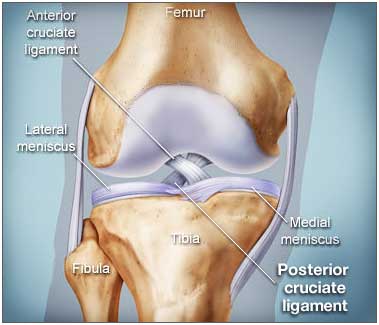
Posterior Cruciate Ligament (PCL) Injuries
 The posterior cruciate ligament is located in the back of the knee. It is one of several ligaments that connect the femur (thighbone) to the tibia (shinbone). The posterior cruciate ligament keeps the tibia from moving backwards too far. An injury to the posterior cruciate ligament requires a powerful force.
The posterior cruciate ligament is located in the back of the knee. It is one of several ligaments that connect the femur (thighbone) to the tibia (shinbone). The posterior cruciate ligament keeps the tibia from moving backwards too far. An injury to the posterior cruciate ligament requires a powerful force.
Cause -
• A direct blow to the front of the knee (such as a bent knee hitting a dashboard in a car crash, or a fall onto a bent knee in sports)
• Pulling or stretching the ligament (such as in a twisting or hyperextension injury)
• Simple misstep
• Sports are a common cause of PCL injury. These injuries are especially common in:
1. football
2. soccer
3. baseball
4. skiing
PCL tears make up less than 20% of injuries to knee ligaments.
• Injured ligaments are considered "sprains" and are graded on a severity scale.
• Grade I: The PCL has a partial tear.
• Grade II: The ligament is partially torn and is looser than in Grade I.
• Grade III: The ligament is completely torn and the knee becomes unstable.
• Grade IV: The PCL is damaged along with another ligament in the knee.
Symptoms -
• Pain with swelling that occurs steadily and quickly after the injury
• Swelling that makes the knee stiff and may cause a limp
• Difficulty walking
• The knee feels unstable, like it may "give out"
Investigation -
MRI
Treatment-
RICE -
When you are first injured, the RICE method - rest, ice, gentle compression and elevation — can help speed your recovery.
Immobilization -
Immobilize the knee with brace to prevent from moving. Crutches may also be use from putting weight on your leg.
Physiotherapy -
As the swelling goes down, a careful rehabilitation program is started.
1. Specific exercises will restore function to your knee
2. Strengthen the leg muscles that support it.
3. Strengthening the muscles in the front of your thigh (quadriceps)
4. Give modalities for pain relief.
5. Walking or running in a pool or on a treadmill
Surgical reconstruction of the PCL is only recommended for grade III PCL tears. Post- Operative physiotherapy is also given for better recovery.

